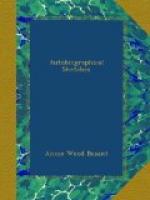proved even livelier on September 25th and 26th.
Mr. Bradlaugh lectured there on September 25th to an
accompaniment of broken windows; I was sitting with
Mrs. Wolstenholme Elmy in front of the platform, and
received a rather heavy blow at the back of the head
from a stone thrown by someone in the room. We
had a mile and a half to walk from the hall to Mrs.
Elmy’s house, and this was done in the company
of a mud-throwing crowd, who yelled curses, hymns,
and foul words with delightful impartiality. On
the following evening I was to lecture, and we were
escorted to the hall by a stone-throwing crowd; while
I was lecturing a man shouted “Put her out!”
and a well-known wrestler of the neighborhood, named
Burbery, who had come to the hall with seven friends,
stood up in the front row and loudly interrupted.
Mr. Bradlaugh, who was in the chair, told him to sit
down, and as he persisted in making a noise, informed
him that he must either be quiet or go out. “Put
me out!” said Burbery, striking an attitude.
Mr. Bradlaugh left the platform and walked up to the
noisy swashbuckler, who at once grappled with him
and tried to throw him; but Mr. Burbery had not reckoned
on his opponent’s strength, and when the “throw”
was complete Mr. Burbery was underneath. Amid
much excitement Mr. Burbery was propelled to the door,
where he was handed over to the police, and the chairman
resumed his seat and said “Go on”, whereupon
on I went and finished the lecture. There was
plenty more stone-throwing outside, and Mrs. Elmy
received a cut on the temple, but no serious harm was
done— except to Christianity.
In the summer of 1875 a strong protest was made by
the working classes against the grant of L142,000
for the Prince of Wales visit to India, and on Sunday,
July 18th, I saw for the first time one of the famous
“Hyde Park Demonstrations”. Mr. Bradlaugh
called a meeting to support Messrs. Taylor, Macdonald,
Wilfrid Lawson, Burt, and the other fourteen members
of the House of Commons who voted in opposition to
the grant, and to protest against burdening the workers
to provide for the amusement of a spendthrift prince.
I did not go into the meeting, but, with Mr. Bradlaugh’s
two daughters, hovered on the outskirts. A woman
is considerably in the way in such a gathering, unless
the speakers reach the platform in carriages, for
she is physically unfitted to push her way through
the dense mass of people, and has therefore to be looked
after and saved from the crushing pressure of the
crowd. I have always thought that a man responsible
for the order of such huge gatherings ought not to
be burdened in addition with the responsibility of
protecting his female friends, and have therefore
preferred to take care of myself outside the meetings
both at Hyde Park and in Trafalgar Square. The
method of organisation by which the London Radicals
have succeeded in holding perfectly orderly meetings
of enormous size is simple but effective. A large
number of “marshals” volunteer, and each




